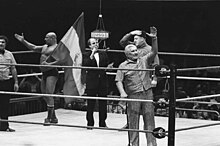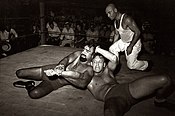
Back هيل (مصارعة) Arabic Heel Danish Anexo:Términos de lucha libre profesional#H Spanish Heel (catch) French Heel (wrestling) Italian ヒール (プロレス) Japanese 악역 (프로레슬링) Korean Heel (professioneel worstelen) Dutch Wrestling#Podział na postacie i style walki Polish Heel Portuguese

| Part of a series on |
| Professional wrestling |
|---|
 |
In professional wrestling, a heel (also known as a rudo in lucha libre) is a wrestler who portrays a villain, "bad guy",[1] or "rulebreaker", and acts as an antagonist[2][3][4] to the faces, who are the heroic protagonist or "good guy" characters. Not everything a heel wrestler does must be villainous: heels need only to be booed or jeered by the audience to be effective characters, although most truly successful heels embrace other aspects of their devious personalities, such as cheating to win or using foreign objects. "The role of a heel is to get 'heat,' which means spurring the crowd to obstreperous hatred, and generally involves cheating and any other manner of socially unacceptable behavior."[5]
To gain heat (with boos and jeers from the audience), heels are often portrayed as behaving in an immoral manner by breaking rules or otherwise taking advantage of their opponents outside the bounds of the standards of the match. Others do not (or rarely) break rules, but instead exhibit unlikeable, appalling, and deliberately offensive and demoralizing personality traits such as arrogance, cowardice, or contempt for the audience. Many heels do both, cheating as well as behaving nastily. No matter the type of heel, the most important role is that of the antagonist, as heels exist to provide a foil to the face wrestlers. If a given heel is cheered over the face, a promoter may opt to turn that heel to face or the other way around, or to make the wrestler do something even more despicable to encourage heel heat. Some performers display a mixture of both positive and negative character traits. In wrestling terminology, these characters are referred to as tweeners (short hand for the "in-between" good and evil actions these wrestlers display). WWE has been cited as a company that is doing away with the traditional heel/face format due in part to audiences' willingness to cheer for heels and boo babyfaces.[6]
In "local" wrestling (e.g., American wrestling) it was common for the faces to be "local" (e.g., Hulk Hogan, John Cena, and Stone Cold Steve Austin) and the heels to be portrayed as "foreign" (e.g., Gunther, Alberto Del Rio, Ivan Koloff, The Iron Sheik, Rusev/Miro, Jinder Mahal, and Muhammad Hassan).[7]
In the world of lucha libre wrestling, most rudos are generally known for being brawlers and for using physical moves that emphasize brute strength or size, often having outfits akin to demons, devils, or other tricksters. This is contrasted with most heroic técnicos that are generally known for using moves requiring technical skill, particularly aerial maneuvers.[8]
- ^ Oz, Drake. "Understanding Wrestling Terminology: A Casual Fan's Guide". Bleacher Report. Turner Inc. Retrieved 25 July 2020.
- ^ "Torch Glossary of Insider Terms". PWTorch.com. 2000. Archived from the original on 6 June 2011. Retrieved 10 July 2007.
- ^ Foley, Mick. Have A Nice Day: A Tale of Blood and Sweatsocks (p. 2).
- ^ Sammond, Nicholas (2005). Steel Chair to the Head. Duke University Press. p. 264. ISBN 978-0-8223-3438-5.
- ^ Edison, Mike (4 September 2017). "The Art of the Heel". The Baffler. Retrieved 25 July 2020.
- ^ Ostriecher, Blake. "5 Reasons WWE No Longer Has True Heels Or Babyfaces". Forbes. Retrieved 25 July 2020.
- ^ Esbenshade, Ellie (15 April 2019). "The Geeky Historian: What Happened to Foreign Heels in Wrestling?". The Geeky Historian. Medium. Retrieved 25 July 2020.
- ^ Cocking, Lauren (5 November 2016). "Everything You Need to Know about Wrestling". Culture Trip. Retrieved 25 July 2020.
© MMXXIII Rich X Search. We shall prevail. All rights reserved. Rich X Search